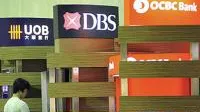
Singapore banks still heavily tethered
Singapore banks spent 2015 bound by slow growth chains and they will not likely break free in 2016.
When Singapore banks rang in the new year, they did so with a lot of trepidation and head-shaking resignation as most indicators point to a tepid, if not terrible, 2016. Earnings are expected to moderate, loan growth will remain lacklustre and increasing corporate leverage will further add fear to an already badly shaken Singapore banking sector.
The malaise in 2015 should continue to extend to this year, and earnings will be moderated as Singapore banks grasp at straws when it comes to growing their revenues. An increase in net interest margin (NIM) could be on the cards, but even this will be blunted by rising funding costs and possibly lower non-loan asset yields.
Given these factors, Singapore bank earnings will grow a tepid 6% in 2016, says Sue Lin Lim, analyst at DBS, down from an expected 15% earnings growth in 2015.
“Revenues are expected to grow at a slower pace for Singapore banks in 2016,” says Lim.“With loan growth likely to stay in the low single digits, topline growth will be slower. Non-interest income is unlikely to excite as well and may be volatile depending on markets, and to some extent, be the wildcard to earnings. As we exit the benign credit cycle, credit costs will start to accelerate.”
“If the excitement of the NIM spike for the Singapore banks cools off, there leaves hardly any drivers for growth in 2016. Judging from the trends we have seen in 2015, we believe that even with the Fed rate hikes, there is not much room for NIM to rise significantly,” she adds.
Sluggish loan growth will not only continue to pummel Singapore banks’ revenues, but Lim says their non-interest incomes will also remain depressed amid the challenging macro-environment.
“We have already seen wealth management income moderating as customers have turned cautious and are switching to deposits instead of investment related products which translates to lower wealth management fees earned,” says Lim.
“We expect similar trends to persist in 2016 until the risk-on sentiment dissipates. We have forecasted overall non-interest income growth to be in the single digit levels in 2016,” she adds, noting that trading and investment income can still serve as wildcards depending on market opportunities.
Lim recognises the potential upside surprise from a higher-than-expected NIM increase, with every 10bps increase in NIM translating to 4-7% rise in earnings. But she believes that, based on 2015 trends, any rise in NIM from SIBOR hikes will be muted, for three reasons.
First, while loan yields will be priced up accordingly, Lim expects funding costs to catch up both within Singapore and at the banks’ regional operations, especially Malaysia for UOB and OCBC, which is the second largest profit contributor to these banks. Second, Singapore banks’ S$ loan-to-deposit ratio have reached a high of 87% from 79% two years ago which Lim says may imply that liquidity has somewhat tightened and there is little room to further leverage on; this would add pressure to S$ deposit costs. Finally, if Singapore banks still carry surplus US$, a situation seen in early 2015, this may dampen non-loan asset yields and hence overall NIM.
Loan growth to remain sluggish
2015 saw the Singapore banking sector decelerate to its slowest loan growth in five years, which dragged down revenues, and this trend will persist in 2016, according to analysts.
“With expectations of lacklustre gross domestic product growth coupled with regional economies grappling to pick up growth, Singapore banks’ loan growth will likely drift down and stay below the 5% level in 2016. Forex translation may just add an additional 1-2bps to overall loan growth, bringing our modelled loan growth forecast close to 5%,” says Lim.
“Total loan growth is likely to remain tepid through the end of 2016, and we have downgraded our forecast for loan market growth to a single-digit of 5.0% for the year, down from 10.0% previously,” echoes BMI Research.
“The Singapore banking sector is in dire straits at present. The headwinds in the broader economy combined with the evolving commodity crunch have compounded vulnerable asset quality and seen lending activity in the city state grind to a near halt,” adds BMI Research.
Dealogic data show that as of December 2015, Singapore syndicated loan activity nosedived to US$23.1bn (via 56 deals), down 59% year-on-year from US$55.9bn recorded (across 104 facilities) in the same period in 2014.
“Put into a broader context, this means that borrowers have successfully secure fresh loan facilities at their slowest rate in five years, since US$15.5bn was tallied up in 2010,” says BMI Research.
In fact, Singapore’s three largest lenders - OCBC Bank, UOB, and DBS Group - have all endured disappointing single-digit growth over recent quarters, with the lenders securing 1.0%, 0.4%, and 2.0% in credit growth respectively as recently as the third quarter of 2015.
Singapore is not alone in the region, with other countries also experiencing slower loan growth. Southeast Asia syndicated loan activity has also dropped to US$54.4bn as of December 2015, also equating to the lowest haul of deals in five years since the same stage in 2010, and representing nearly half the US$109.2bn borrowed across the region in same period in 2014.
Rising corporate leverage and NPLs
On top of crumbling earnings and lacklustre loan growth, Singapore banks should also spend 2016 grappling with the threat of increased corporate leverage and non-performing loans (NPLs).
“Together with the fall away in lending activity, the banking sector in Singapore has ongoing concerns relating to the persistently high level of NPLs,” says BMI Research. “Singapore's banks face an uncertain outlook over the coming quarters amid a subdued regional economic environment and continued financial market volatility.”
In November 2015, the Monetary Authority of Singapore published its Financial Stability Report, which showed an increase in nonperforming loan (NPL) ratios across Singapore banks, says Simon Chen, VP-senior analyst, at Moody’s Investors Service.
He notes that as of September 2015, the corporate NPL ratio was 1.8%, compared with the three-year average of 1.6%. Also, as of June 2015, the NPL ratio in the small and medium enterprise (SME) sector was 1.3%, higher than the three-year average of 0.9%.
Chen also reckons that 2015 data indicates eroding credit quality of domestic corporates, which is a credit negative for the Singapore’s three domestic Singapore banks as their asset quality will be negatively pressured, leading to higher credit costs and more constricted capital generation.
“These headwinds will erode banks’ capital levels as profitability weakens and negative credit migrations result in higher risk weights on their credit exposures,” says Chen.“Nevertheless, the Singapore banks will still have strong capital buffers. As of September 2015, all three banks had common equity Tier 1 ratios well above regulatory minimum of 9%, which includes 2.5% capital conservation buffer and 2% buffer for domestic systemically important banks.”
Lim agrees that asset quality as of December 2015 remains relatively healthy. “So far, an asset quality capitulation appears remote. But banks have been prudently setting aside additional provisions where required.” Stress tests have been carried out on selected portfolios, particularly the commodities and oil and gas sectors, but so far, there has been little stress, but she warns that worse-than-expected unemployment numbers could further diminish asset quality.



















 Advertise
Advertise








